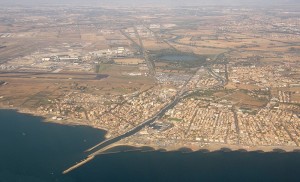 British archeologists led by University of Southampton have recently found evidence that sheds light on how Portus was destroyed. Portus, was by all historical records and accounts a port unlike any other. The port could host 350 ships at a time and kept the ravenous capital of the Roman Empire supplied with grain, wine, oil, slaves and luxuries from around the world.
British archeologists led by University of Southampton have recently found evidence that sheds light on how Portus was destroyed. Portus, was by all historical records and accounts a port unlike any other. The port could host 350 ships at a time and kept the ravenous capital of the Roman Empire supplied with grain, wine, oil, slaves and luxuries from around the world.
The archeologists also believe that they have unravelled the mystery of how the site’s luxurious palace and huge warehouse vanished almost overnight, leaving no trace of the port’s scale and wealth as Guardian Newspaper reported. It was previously believed that the port and the beautiful palace had been burnt down by invading barbarians or Ostrogoths. However, the new picture drawn by the archeologists show that as the empire declined, Portus was systematically demolished in the 6th century by the Byzantines – the eastern emperors who fought the invading Ostrogoths to regain control of Rome. In addition, the archeologists discovered that the magnificent, three-story palace was in fact flattened and the 50ft walls were destroyed methodically. It is believed that by the 6th century, the Byzantines felt the port could be a threat as it was vulnerable to being occupied by the Ostrogoths, so they took the decision to destroy it themselves.
Portus was very important to the Roman Empire and new findings further emphasize the grandeur of what the port. The archeologists found the 60-room imperial palace covering nine acres. It was fronted by a long colonnade and boasted a first floor courtyard with a pool fed by a cistern below. The remains of an amphitheatre and an enormous, 260-yard long warehouse have also been discovered.<
Built by the emperor Trajan in the second century, Portus included a mile-wide main basin that has now silted up, and an inner, hexagonal basin that still exists as a lake in woodland at the end of the runway of Rome’s Fiumicino airport – it’s perfect hexagonal shape is clearly visible from above.
The Byzantine Empire was the predominantly Greek-speaking continuation of the Roman Empire during Late Antiquity and the Middle Ages. Its capital city was Constantinople (modern-day Istanbul), originally known as Byzantium. Initially the eastern half of the Roman Empire (often called the Eastern Roman Empire in this context), it survived the 5th century fragmentation and collapse of the Western Roman Empire and continued to thrive, existing for an additional thousand years until it fell to the Ottoman Turks in 1453 (Wikipedia).















